By Father P.J. O'Connor
1937
Below, on this page are pages 28-53. For the rest of the book go to:
PAGE 28
"For the first few years at St. James the poverty of the Sisters was acute. Of course, this poverty was accidental, for it was never intended that Sisters engaged in strenuous active labor should practice the same poverty as cloistered nuns. Furthermore, had they made known to the Motherhouse their sufferings, the Congregation itself would have come to their relief. But there was something of Franciscan blitheness of heart about them that made them rejoice in their poverty. Then, too, they bore in mind that in leaving all for Christ, they had found all, and how could anything be hard when it was borne for Him Whose love made the burden or daily toil very light and the yoke of poverty strangely sweet.
"St. James school is built upon the side Of a hill. The architect had been rather too sanguine that the grade of the land would afford sufficient drainage. It did afford drainage, but it was into the building, with the result that walls, furniture, children and teachers were a state of chronic perspiration, while the floors fairly reeked with dampness. One can readily appreciate that the effect upon the health of human beings exposed to such conditions was not quite as medicinal as that of a European spa. Before long, rheumatism and kindred ailments manifested themselves in the Sisters. This was the only time that Sister Catherine ever seemed to completely lose courage, the devil, no doubt, multiplying the obstacles to prevent a work destined to promote, in a remarkable degree, the salvation of souls.
"At this critical moment, Providence sent a good friend to the Sisters, a friend whose strong, clear guidance was thereafter a wonderful help in the midst of their many perplexities. It happened in this way. The new president of the Christian Brothers College, Brother Justin, had arrived in St. Louis at the same time that St. James School was opened. He had known Sister Catherine in New York and the threads of their friendship were now picked up. Sister Catherine laid before Brother Justin a statement of her difficulties. He made a thorough survey of the school building, then sought an interview with Father Casey, and suggested to him a plan by which the building might be drained. Fortunately, the priest was open to conviction and engineers were put to work, the dampness was overcome, the basement ceased to be a menace to health, and Sister Catherine never again lost confidence that, with the divine blessing the work at St. James would ultimately prosper.
"For three years the Sisters at St. James taught in the basement and then Father Casey -- again urged by Brother Justin -- was prevailed upon to overcome his diffidence about incurring debt and put up part of the superstructure of the school. Four large classrooms were finished in time for the opening in September, 1906. With two grades in each room, the four Sisters conducted an eight grade school with the happiest results. The children responded to their teaching in the secular branches of learning as well as to their spiritual instructions. Sister Catherine gave to the Sisters the example of bringing always a joyous atmosphere into the classroom, knowing well that a cold, unsympathetic Sister would be but a sorry messenger to carry the story of God's infinite mercy to little children. Sodalities were formed, the liturgy of the Church was taught, and childish voices were soon heard, sending their act of petition and love heavenward. The happiest relations were established between the parishioners and Sisters, Sister Catherine in particular being made the depository of confidences concerning personal or domestic difficulties, to which the natural uprighteousness of her judgment, and the inspirations of faith enabled her to offer the happiest solution.
"In the meantime the bond of sympathy and mutual respect which united the saintly old Brother Justin with the Sisters was strengthened. No father could have bestowed on his daughters tenderer care than did Brother Justin on the four lone Dominicans in St. Louis. There were days when an old-fashioned coupe would drive up to the door and from its depths would emerge a small figure bearing a couple of well-filled market baskets. To learn of the indisposition of a Sister was the signal for Brother Justin to appear on the scene with every known remedy to restore her to health. It is not surprising that the name of this great and good man, esteemed by the entire hierarchy of the United States as well as by his own brethren, is held in the tenderest remembrance by the Sisters of our Congregation everywhere.
"Since their coming into his archdiocese the Most Rev. Archbishop Kain had been solicitous for the advancement of the Sisters and at all times showed a deep and abiding interest in all that concerned them. At no small personal sacrifice he frequently made time to encourage them by his gracious presence. In April, 1903, his ever-increasing ill health necessitated the appointment of a coadjutor in the person of Rt. Rev. J. J. Glennon of Kansas City, who took upon his strong young shoulders the burden which Archbishop Kain was glad to lay down. Only a few short months of life were left to him, and on October 13, 1903, the saintly Archbishop
PAGE 29
passed to his heavenly home. In his successor, the greatly beloved Archbishop Glennon, the Sisters have found the same kindly dispositions. Under his benevolent administration they have steadily progressed, and with God's help, will continue to do so. Not only the external gifts of Archbishop Glennon, his eloquence, his simplicity, his distinction, but also his qualities of mind and heart, possess a peculiar charm for all who meet him.
Preparations for the World's Fair in St. Louis began in 1902. The Fair happened to be held within the boundaries of St. James' Parish. Father Casey offered Mass on Sundays during the Fair in the Administration Building to accommodate the many employees who were detained on the grounds. On September 6, 1902, he baptized the World Fair's Baby, Louisiana O'Leary, a child which was actually born in one of the concessions. The record of the baptism reads:
"September 6, 1902. The undersigned baptized with Archbishop's consent, in the Washington University (now used by the Louisiana Exposition Company and known temporarily as the Administration Building), Louisiana, first baby born in World's Fair District, daughter of Lawrence O'Leary and Mary, his wife. Sponsors of honor -- Director of Works: Isaac G. Taylor and Miss Florence Howard; Sponsor of Rite, Rev. J. S. Long; born August, 1902. E. A. Casey, Rector World's Fair District."
With few exceptions, houses erected in the Parish during the Fair were of cheap construction and later were rented by the very poor people who, compelled by necessity to live in these apartments, were in Father Casey's time, and are still, an unsolved parish problem. Usually there are many children, healthy, robust intelligent and half-naked. A large percentage of them are Catholics. They drift from every part of the City, but especially from the well-to-do parishes where there happens to be an efficient and active branch of St. Vincent de Paul. These zealous Vincentians advise these poor parishioners to move to a locality where rents are low, meaning where shacks that are not fit for human habitation can be rented for $12.00 a month. They state the Head Conference will take care of them in their new location. There is no provision made for the Catholic education of these children, thus it has been for years St. James Parish has been under a terrific strain providing school rooms, free books, and teachers for children that should be cared for in the parishes that have a residential aristocracy and no homes for the poor.
The Universal Exposition in St. Louis, celebrating the one hundredth anniversary of the Purchase of the Louisiana Territory, now comprising fourteen states and territories, was a stupendous enterprise carried out with acknowledged success. It assembled the industries, the art and the processes of the world. It was a meeting of the people of the earth, representing practically all nationalities, tribes and kindred. By universal consent it surpassed all previous expositions in extent, picturesqueness, variety of detail, and interest. The great Exposition was for seven months a city of light, life and music.
The first faraway glimpse was of countless towers, domes and steeples among the tree tops. The main picture centered around a grand basin and plaza walled in on either side by majestic facades of palaces and filled in front by terraces, cascades, colonnades, Festival Hall and the pavilions rising hundreds of feet from the water, with everywhere the forest -- foreground, background and border.
A sunken garden was there long, narrow, a ribbon of color, many hued, on the south towering the quaint front and over-hanging roof and obelisks of the Palace of Mines, on the north the lofty arches and doric columns of the Palace of Liberal Arts. The scene changed. A lagoon wended its angled course under arched bridges. between terraces, in the shadows of overhanging maples. An avenue winding and climbing upward through the forest led away from the Palaces into the midst of the mansions of many States scattered upon wooded knolls and slopes. Hospitality, the social evolution of American official life, found its highest type of expression in the half hundred spacious reception rooms along Commonwealth avenue and the ways which led from it. In striking contrast with the Plateau of States was the Place of Nations, with town halls, and villas and reproductions of famous structures in many lands, with gardens and surroundings closely typical of the various countries.
(WALTER B. STEVENS--The World's Fair.)
PAGE 30
A newspaper account of the Golden jubilee celebrating the founding of St. James held in July 1912 states that the celebration began on Saturday afternoon with a lawn fete, athletic contests and a euchre on the church grounds and ended Sunday with the celebration of Solemn Field Mass which was said directly in back of the Rectory and where, as many of the parishioners now will recall, was held the memorial children's entertainments and graduation for many years.
The Mass was celebrated by Father Joseph Casey, assisted by Father John R. Morgan and Father P. D. O'Connor, as deacon and sub-deacon. Father Francis Gilfillan, later Bishop of St. Joseph, Mo., was Master of Ceremonies. The sermon was delivered by Rev. Alexander J. Burrowes, S. J., President of St. Louis University at that time, who took as his text "Not, on Bread Alone Doth Man Live." Other priests assisting in the ceremonies were: Father Foley of St Cronan's, Father Clark of Maplewood, Father Lavery of Holy Rosary and Father Tallon of the Visitation.
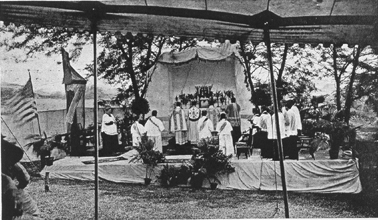
Music was furnished by one hundred members of the Knights of Columbus Choral Club, and St. James Choir and was a particularly enjoyable feature of the celebration.
The article further states that John Casey and Robert Fox who attended the dedication of the original Church January 1, 1861 were introduced by Father Edmond A. Casey and told of their difficulties in reaching "Dry Hill" as the site of the church was then known. It further stated that the parish had suffered a setback after the World's Fair when scores of the parishioners attracted by the enhanced valuations of real estate, due to the proximity of the Exposition, sold their holdings and left Father Casey to fare the fight alone. He persisted in claiming the parish was now in another wave of prosperity.
The Golden Jubilee celebration was turned into a home-coming fete by the attendance of hundreds of members of the fifteen parishes that formerly comprised St. James' Parish. The renewal of old friendships was the feature of the Field Mass on Sunday just as we hope that the celebrations planned for the Diamond Jubilee will be. (Republic, July 12).
PAGE 31
1900-$2,500.00; of this sum $1,665.00 was made on Festivals.
1901-$3,213.00; of this sum $1,395.00 was made on Festivals.
1904-$4,339.00; of this sum $1,134.00 was made on Festivals.
1907-$4,749.00; of this sum $280.00 was made on Festivals.
1908-$5,281.00; of this sum $1,094.00 was made on Festivals.
In 1907 the parish indebtedness was $17,200-00. The interest on the loan was $1.020, the deficit was $1,800. (Chancery Office, Diocesan Archives)
With the highest regards for Sister Loyola and a sympathetic understanding of the many difficulties and privations suffered by the Sisters, a critical analysis of her history compels me to say, she has overdrawn the picture when she states, "For the first few years at St. James the poverty of the Sisters was acute. There were days when an old-fashion coupe would drive up to the door and ... a small figure (Brother Justin) would emerge bearing a couple of well filled market baskets." The implication is the Sisters needed food. It is difficult to understand how this could happen in St. James parish if the parishioners "would gladly have procured for the Sister every reasonable comfort." There were three teachers in the school who received an annual salary of $500.00, and a free Convent, another Sister or one of the three gave music lessons. When a fourth teacher came in 1906 and from that time on the salary of teachers was never less than $750.00 (Diocesan Archives) Mother Thomas knew very well the income the Sisters had, she contracted with Father Casey that one teacher would teach without salary until the parish could balance its budget; this happy event did not come until 1913. Mother Thomas never complained as long as she lived. She had a fine sense of charity. To her missionary zeal, Father Casey's effort and to the many self-sacrificing nuns who taught in the school is due a tribute of gratitude from everyone who has graduated these past thirty-five years from St. James School.
Maintaining a parochial school is one of the big items of expense that keeps pastors worrying. The salary of the teachers is the least of it. There is the initial expense of a site, and construction. Insurance, repairs, heating, lighting and janitor service for school and convent follow. Brother Justin may have encouraged Father Casey to complete the school as Sister Loyola states he did, after the school was well established established in 1906. Father Casey had to go it alone and meet as well as he might the cost of operation. He had a debt of $17,200.00 on the school and an annual interest bill of $1,032.00, with cost of renewal every three years and a demand for a substantial reduction each year on the principal. There is little pleasure for a pastor who knows that the nuns teaching in the parochial school are half starving, especially when he sees no way to create funds to give them a sustenance. The parish undertook too soon the opening of a school and the strain on Father Casey was greater than the parishioners realized. He soon began to fail, first an acute attack of Tuberculosis, later on organic disease of the heart and other complications. He took a few extended vacations. he felt if he could get a transfer to a parish that had less financial obligations he might prolong his life, but the end came sooner than he expected. After he underwent an operation in Cleveland for the removal of a goiter, he took a trip to Tucson, Arizona, in hopes the climate there help him to recuperate. As he neared his destination the train ran into a flooded area. An ambulance took him from the train to St. Joseph's Hospital. The first order he gave the nuns was to get a priest to administer the Last Sacraments. The one that came was rather slow to realize the proximity of death and Father Casey, with a show of irritation, rebuked him saying, "If you don't hurry up I will be dead before I am anointed." His diagnosis was true. He died in a few minutes. This was on January 23, 1916.
His remains were brought to St. Louis and he was buried from St. James Church on January 27. Father Lavery preached at his funeral. He was buried in a private lot in Calvary Cemetery a few hundred feet from the main gate. He had erected on this lot, a year before his death a monumental image of Christ on which he had carved a protest against the modernistic heresy that denies Christ's divinity that was particularly active at this time.
PAGE 32
"Most Reverend Archbishop, Very Reverend and Reverend Fathers and dearly beloved people:

The task has been entrusted to me of placing before your minds today a picture of your deceased pastor, Father Casey, and if in the delineation of that action I should overstep the mark and be untrue to the original it will be due to the loyalty and love which bound me to the deceased during the many years of his priestly life.
The smiles, the tears of childhood's years
The words of love then spoken,
The eyes that shone, now dimmed and gone
The cheerful hearts now broken.
Father Casey's first appointment was as curate to Monsignor Walsh in Saint Bridget's Church, one of the old guard, one of the grand old Irish priests whose name is handed down with reverence, and whose memory shall be always green amongst us. After three years at Saint Bridget's his Archbishop appointed him pastor of Montgomery City, where for sixteen years he labored and where today his name is held in benediction and love by the people, irrespective of creed. Sixteen years in sixteen years in country missions going about from one little mission to another, looking after the scattered sheep, saying Mass sometimes in the little Church, sometimes in the private homes of the people, bringing back the wayward sinner, turning many away from iniquity, and through kindness of heart and priestly love bringing into the fold some other sheep that were not of the sheepfold -- such was Father Casey's life, doing the work of his Divine Master.
Such work, recognized in heaven, could not go unrecognized by the Chief Pastor in this Diocese. Accordingly, when this parish became vacant he was transferred from Montgomery City to St. James' Church and every priest in the diocese was delighted at the appointment. Some nineteen years ago Father Casey assumed charge of this parish. You were then without cohesiveness or solidarity. You were scattered and you were poor, and unfortunately that union that should exist amongst members Of Christ's flock did not obtain in this part of the city. Father Casey knew all this and he came here as pastor of all the people. He felt that he was placed over the House of the Lord and he proved himself the faithful and wise servant, diligently occupied in his Father's business, breaking the Bread of Life and giving to all the measure of food in due season. Your little children were growing up without a Catholic education. This went right straight to the heart of your pastor anti he determined that no matter how poor his people were his parish must have a parochial school. He consulted his Archbishop and with his permission your school was built, a house was procured for a religious community and your little ones were given into the hands of the Daughters of St. Dominic. This school is the source of every measure of success attendant on the labors of your deceased pastor. The people became united through their children and all felt that the church and the school were the common centers of that parochial activity which should always obtain in a Catholic parish."
On June 17, 1916, Rev. Maurice O'Flaherty was transferred from Valley Park and appointed Pastor of St. James Church. He was then 19 years a priest, the great part of which time he spent as Pastor at Poplar Bluff.

He was born near Ardfert, County Kerry, Ireland, ordained in St. Patrick's College, Carlow, and after his ordination was appointed in September, 1897, as assistant pastor of the Visitation Church.
Everybody liked "The O'Flaherty" as he was admiringly named, it was easy to imagine that he had royal blood in his veins and that his forbearers were intrepid Irish Chieftains who chased the wolf and wild boar or guarded a castle in a rugged Promontory of Kerry against the attacks of Danes and Norsemen.
Maurice was an athlete who could run, jump and throw weights. He was an excellent swimmer, and his mental qualities were as well developed as his physical. In the Seminary he excelled in everything.
PAGE 33
He liked to attend Shakespearean plays and on returning home he recited the parts from a book with such dramatic effect, one could easily suppose he out-Hamleted Hamlet. He plays the violin well and has composed music for Mass and hymns with some success. He received a diploma from Siegel Meyers Correspondence School of Music, Chicago, Illinois, December 13, 1914. He is at his best when telling a tale -- as one Irishman to another, or to a dozen. He has a charm Of simplicity and a childishness that conceals nothing good or bad. He was never accused of being uncharitable, but a keen sense of humor urges him to reveal thoughts and action regardless of their implications of himself and others, Maurice is funny, candid and, as the Irish put it, droll, without buffoonery.
The first baptism performed in St. James Parish by Father O'Flaherty was Robert Byrne Mahoney, 6433 Nashville Avenue, July 23, 1916, his last was August 25, 1918, when he baptized Vincent Lanciano.
In October, 1918, Father O'Flaherty left the diocese and became Chaplain at St. Mary's Hospital, Cairo, Illinois, where he is at present. This suits his inclination; he never cared for city life and hated the irritations and responsibilities that cannot well be avoided in a city parish.
Rev. P. J. O'Connor, Pastor of St. James Church, born at Coolkera Listowel, County Kerry, Ireland in the parish of Ballybunion January 1, 1883, son of Cornelius O'Connor and Mary nee Corridan. Baptized at the Chapel Ballydonoghue January 3, 1883, confirmed there July 1895, attended the National School, at Coolard and later Tullamore, entered St. Michael's College, Listowel, August 23, 1897. the ecclesiastical college, Carlow College Sept. 3, 1901, ordained a priest June 9, 1907, said his first mass at the Poor House Chapel Listowel June 11 for the inmates in the presence of a few relatives and Sisters of Mercy.
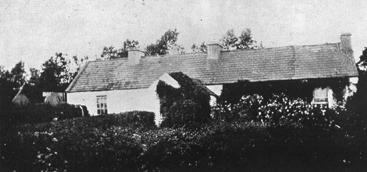
Sailed to America November 1. 1907 on the Celtic and landed in New York, , November 8. Arrived in St. Louis November 20, was AP pointed assistant at St. Edward's Church, St. Louis, December 1 and served there till September 1, 1912 when he was transferred to St. James Church. During the following four years Father Casey was ill or absent from the parish the greater part of the time and Father O'Connor had all the responsibility. In the interim, from the death of Father Casey in 1916 till Father O'Flaherty was appointed pastor, Father O'Connor was Administrator. On December 10, 1918, he was again appointed administrator and Nov. 14, 1929 this appointment was made permanent.
Recently a man at Cooksville, Indiana is reported to have preached his own funeral service in the Canaan Church to an audience of 5,000. He opened his "sermon" with "This is a very prominent occasion There never has been no such occasion in the world."
As the writer of this history happens to be writer of his own biography, all I can say is "This is a very prominent occasion" and as
PAGE 34
all this is new to me, I will add only another quotation from the same -- Wade Mellman, "Columbus wanted to preach his own sermon," he said, "So did Napoleon and Napoleon's wife, but they didn't," he shouted, "I am." (Associated Press report.)
So we will leave it go at that, with a request that my enemies forgive, me and my few friends pray for me.
Father McNamee was assisted a year or two by Father Orphy, an Italian. He was a carpenter and built an altar for the old church. After it was erected it did not please Father McNamee's aesthetic taste and was not accepted.
Father Francis Diel, a German, served Father Casey for a few months. He assisted at the blessing of the bell that was set up by Father Casey between the church and rectory. That day he contracted a cold and died of pneumonia at the Alexian Brothers' Hospital, March, 1897.
Rev. Denis Mulcahy. now pastor of Immaculate Conception, Brookfield, Missouri, was assistant to Father Casey, 1903-1904-1905. His name does not appear often in the parish records.

Rev. Joseph English, now pastor of the Epiphany Church, assisted Father Casey from August 15, 1909, to September 8. 19114. He administered the affairs of the parish for 9 months.
Rev. Pete J. Dempsey, late pastor of the Church at Richwoods, assisted Father Casey from September, 1911 till June 20, 1912.
Rev. Joseph McGinley, late pastor of Potosi, served a few months at the time of the Golden Jubilee and preceded Father O'Connor.
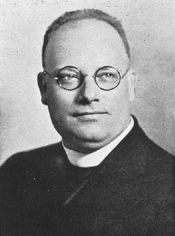
Father Pohl was appointed assistant pastor to St. James Church, January 2, 1919, and has served the parish to the present: The morning he said his first Mass in the parish was very cold. The Janitor with the intention of giving him a warm reception heaped on coal. After Mass was said the old Church went on fire as the result of an overheated furnace. Hence his first Mass in the parish marked the new era of progress and parish construction. Father Pohl was ordained at Kenrick Seminary on December 21, 1918. St, James was his first appointment.
PAGE 35
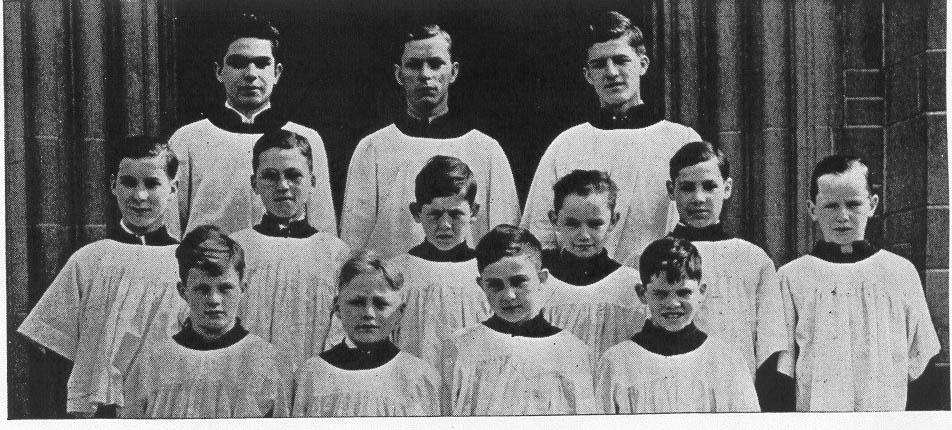
ALTAR BOYS
Back Row: John Palumbo, Robert Anderson, Charles Billings.
Middle Row: Thomas Brady, Lawrence Schieber, John Regan, Dolan Walsh, Paschal Rocchio, Eugene Walsh.
Front Row: Donald McMahon, Robert Houlihan, Leonard Garavaglia, Robert McVey
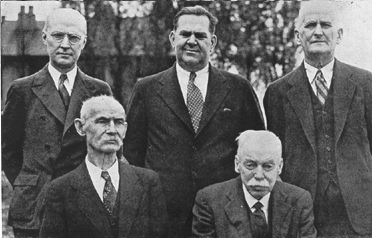
COUNCIL OF ADMINISTRATION
Front Row: Mr. James P. O'Gorman, Mr. Joseph Crotty.
Rear Row: Mr. Martin C. Coad, Mr. Chas. M. Heil, Mr. Hy. C. McCauley
PAGE 36
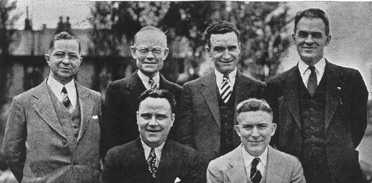
TELLERS
Top Row: Mr. E. C. Chewning, Mr. R. C. Mellor, Mr. Thos. O'Toole, Mr. C.P. Billings
Front : Mr. Emmett O'Keefe, Mr. Bernard P. Brady.
These count the cash and are jocularly called the money changers. Their answer is: "The sky is often very cold -- a church cannot be run without money."
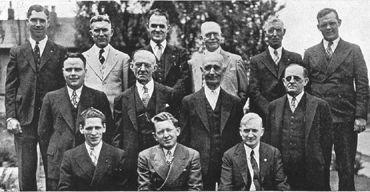
USHERS
Front Row: Lawrence Bienecke, Albert Polster, John Kelly.
Second Row: Emmett O'Keefe, John O'Hare, John Manion, George Wilber.
Third Row: Charles Eckert, Bernard Brady, Charles Billings, P.H. Murphy, Pat Regan, Louis Schmid
PAGE 37
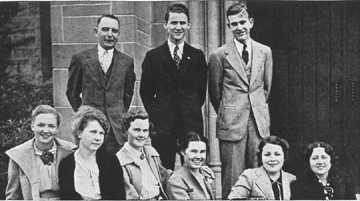
CLERICAL STAFF
Top Row: Mr. Frank Peistrup, Mr. Thomas O'Shaughnessey, Mr. Robert Jorgens.
Bottom Ro: Miss Bernice Schwable, Miss Anna Kurz, Miss Catherine Maloney, Miss Irene Gardner, Miss Agnes Frattini, Mrs. Morgan P. Foley.
This staff keep parish accounts, acting as stenographers and doing general clerical work. They meet once a week in the rectory and are directed by Frank Peistrup of Dolan's Real Estate. Ruth Diefenbach is also a member.
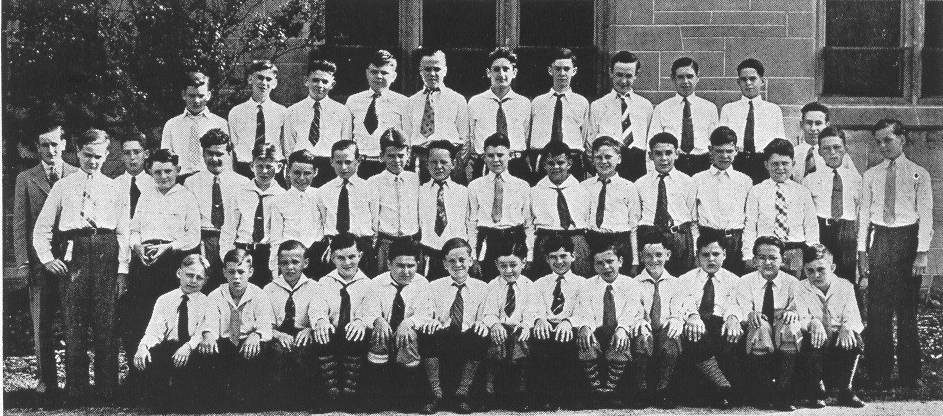
PATRICIAN CHOIR
Front Row: Robert Houlihan, Robert Droege, Robert Reese, Thomas Duggan, Eugene Mazzucca, Thomas Menner, Emmett O'Keefe, Joseph Daniels, Daniel Mirrelli, William Kelly, Peter Sharamitaro, Joseph Bigney, Leonard Garavaglia.
Second Row: Paul Bequette, David Saxton, Russell Rawie, John O'Hare, Anthony Mirrelli, James McMahon, James O'Shaughnessy, James Walsh, John Buckley, Walter Leblein, Robert Marshall, Charles Schmid, Philip Schwable, William Godfrey, William Diefenbach, John Cummins, William Flanagan, Lawrence Schieber, Joseph Eichner.
Third Row: Thure Zundel, John Thomasson, Owen Thompson, Robert Dolan, William Cumberland, Louis Santambrogio, Vernon Page, John Weaver, John Murphy, George Meier.
PAGE 38
This began as a boys' choir in 1935 and has pupils selected from the boys of the sixth, seventh and eighth grades of the parochial school. It was organized with the intention of making it a permanent choir and the boys have promised Father O'Connor that they would continue to sing after they were no longer under the jurisdiction of the parochial school. It was Father O'Connor's intention that these would develop into members of the adult choir. They receive their special training from Mrs. John McKeon.
This choir sings the authentic Gregorian Chant and performs the special chanting during the Holy Week Services and in all the Processions. They also sing High Mass on the third Sunday of the month during the winter season, and on all other special occasions. It is composed of over forty members.
As a compliment to Father O'Conner, it was named the Patrician Choir after the Latin word Patricius which means Patrick.
On the North: The north line of Forest Park from Skinker to Kingshighway.
On the South: North side of Elizabeth Avenue to Clifton Avenue and a line from the Old Manchester Road to McCausland Avenue. (Custom permits Catholics along this boundary to join St. Aloysius Church.)
On the East: From Lindell, the east line of Forest Park to Oakland Avenue and west side of Macklind Avenue from Oakland to Elizabeth.
On the West: McCausland Avenue to Bruno (east side of street). South side of Bruno to Forest. East side of Forest to Cutter to Oakland Avenue, and Skinker to Lindell.
The Congregational Church at Victoria Avenue and Graham Street, is the only outstanding Protestant Church within the boundary lines of St. James Parish. It originated in the zeal of a woman who saw that the spiritual welfare of the Protestant people of the district had been neglected. Mrs. Adeline Rogers Johnson, about 57 years ago, held a meeting in her home, now in the site of Forest Park Highlands and urged the opening of a mission church. To harmonize interest she acceded to the general wish that the church be Congregational, though she was an Episcopalian. Until the church was erected services were held in the Johnson home.
It was in the frame structure at West Park that "The Cheltenham Congregational Church of St. Louis" was organized August 20, 1882, and from which has emerged the organization now properly called the "Memorial Congregational Church" -- after the good Dr. Goodell, a former pastor of Pilgrim Congregational Church, who took a deep interest in the new congregation.
The first church building was a small frame structure 20x40 feet, situated on West Park, between Sublette and Pierce Avenues. Work was begun April 13, 1882, and the building was finished and completely furnished, June 20, 1882. It cost, including lot, $550, The second edifice was built at the corner of @Sulphur and Way Street. It was dedicated Oct. 7, 1888, and vacated June 9, 1912, after a period of nearly 24 years of service. It cost, including the lot, $5,500. On May 1, 1905, the Board of trustees voted to accept the offer of Mr. Ben Gratiot and purchased the lot at Victoria and Graham on 0ctober 23, 1905 for $1500,00. On January 17, 1910 the Building Committee was appointed. Ground was broken for the new Memorial Congregational Church August 23, 1911. The cornerstone was laid October 14, 1911. The building was dedicated November 17, 1912. It is of English Gothic design, built of red brick, trimmed with Terra Cotta. The church proper seats about 300 people. The total cost of the building including lot and furnishings, was about $24,042.00, not including at least two substantial donations in materials and labor. The pipe organ cost $2500. Mr. Curtis S. Bainum was the architect and builder.
The exterior arrangement of the Church is a dark brown brick with light colored trimming of terra cotta upon a light stone foundation. The color scheme of the exterior being in harmony with the dark blue slate roof. The principal features of the design are a front and transept gables with their large windows. The window in the front of the church is large and attractive in design and coloring.
The interior arrangement provides for a large Sunday School room in the basement, with adjoining class rooms that can accommodate 400 children. In the basement there is also a kitchen, boiler room, boys' club room, toilet, etc, In this part of the building there are four entrances. The main floor auditorium is arranged in the form of a cross, with wide aisles and clear story windows for transept and nave. The ceiling 36 feet high has ornamental wood trusses exposed to view, with plaster
PAGE 39
panels between them. The auditorium seats 384 persons. On the main floor is the pastor's study, choir room, organ loft, rest room, etc. The building is steam heated.
The first pastor of the Memorial Congregational Church was Wm. Smith, a graduate of the University of Edinburgh, Scotland. The present pastor is Mrs. Ada Stone Anderson, who is frequently assisted by her husband, Rev. Frank Anderson, both of Annalee Avenue, Webster Groves, Mo.
Although this congregation is a rival in the religious field the members of St. James Church and the Memorial Congregational Church have never had a semblance of dislike for one another. Both churches have made it a point to inculcate the charity of religious tolerance. On one point of doctrine at least both agree, and that is "Love is the fulfilling of the law."
Among the Charter Members of the congregation were William C. Johnson, the Winkles, Handleys, Hewitts, Stokes, Kerr, etc.
This institution stood until a few years age on the south side of Oakland Avenue, east of Hampton, on a piece of ground about seven acres in extent. The building and the, grounds were very picturesque. The institution was sometimes called Mrs. Cairns' University for Women.
Anna Sneed Cairns, the founder of this University was a daughter of Rev. Samuel R. Sneed, a Presbyterian minister widely known in Kentucky and Indiana before the Civil War. She married John G. Cairns, an architect, who designed the University. Forest Park University was the first University to be chartered solely for women in the United States. (Hyde and Conard History.)
To Mrs. Cairns is attributed the extension of the Market Street car line to Richmond Heights. "There is nothing," Mr. Stephen's, in his History of St. Louis, says, "so astonishing as the manner in which Mrs. Cairns carried the legislation that gave the south side of Forest Park and the University it's street car facilities." Mrs. Cairns pushed the movement along until it reaching the House of Delegates. When the ordinance reach the Mayor, it was vetoed. Again she went into battle and, after two years, won her firght and, pupils of Forest Park University began to ride to and from the institution on street cars.
She founded Kirkwood Seminary in 1861. This later became Forest Park University and the location was changed in 1891 to Oakland Avenue.
For the past fifty years Dr. R. Brent Murphy is the first person the Priests of St. James Parish call when they have an ache of a pain. Regardless of the time he is called, day or night, there is not delay; he is always ready to serve and help the Pastors. He has been a true friend of the Parish.
Dr. Murphy was born at Old Mines, Washington County, Mo., on February 16, 1867. He was the son of Wm. S. Murphy and Eliza G. Brent Murphy. When Dr. Murphy was about six years of age, he and his family lived on a farm near Crystal City, Mo. Three years later they moved to a farm on the Meramec River, opposite the Meramec Highlands in St. Louis County. He lived on the farm until he began to practice medicine.
He received his grade school education in private schools in Kirkwood, and public school in Fenton. He also attended Christian Brothers College, at that time a boarding school at 8th and Cerre Street --the following year at Easton Avenue and Kingshighway. He graduated from this school in 1884.
Received his degree in Medicine from St. Louis Medical College located at 7th and Clark in 1889. Interned at St. Louis Female Hospital on Arsenal Street across the street from the present Isolation Hospital. Opened his office at 5753 Manchester Avenue an May 19, 1890.
His father died in November, 1900. He built his present home at 6120 Victoria Avenue, and with his mother and half-sister moved into it in July, 1901.
On August 19, 1903, he married Mayde Williamson at Memphis, Tenn. They have four children: R. Brent, Wm. Talbot, Mayde, and John Carroll.
PAGE 40
The extensive field which St. James Parish included within its boundaries 75 years ago, is difficult to define. The Watermans, DeGivervilles, Blossoms, Sam Cabanne and others came from the district now in St. Roch's, St. Rose's and Our Lady of Lourdes parishes.
Charles Handly, John Handly, John and Nicholas Craven, the Crowly family drove in from Big Bend and Hanley Roads; the Boland and Thomas families from Claverach, Mr. and Mrs. John Donnelly, parents of the Chancellor of this Archdiocese, Monsig. George Donnelly, resided at Berthold's Grove, the first convert to the Church was Annie Sambolo, the maternal grandmother of Father Reeves, Pastor of Our Lady Help of Christians. This family lived on the "Nuns" farm near where the oil tanks are now located in Shrewsbury.
There are families on record who came from Webster, Ellendale, Gravois Road, Rock Springs.
Amongst the charter members of the parish were John Quinn, Patrick Flood, John Quigley, Sanguinette Benoist, John Wilson. Alfred Brooks, Patrick Connors, Richard English, Michael Lucy, George Rogers, Patrick Collins, John O'Gorman, Lawrence Harking, James McDermott, James Rooney, Michael Power, Jean B. Bompart, William Martin, Joseph Brazeau, John A. Murdoch, John McNamee, Patrick Gilhooly, Patrick McDonough, Martin Concannon, John King, Manus O'Regan. William Bresnahan, David Walsh, John Welby, James Lancaster, Jeremiah Quinlan, Jeremiah McNamara, Hugh Shields, John Loftus, Timothy McSweeny, William Reily, Patrick Walsh, John Connor, Martin Murphy, Patrick Conely, Thomas Cook, John Ward, William Brady, John Robinson, Patrick Cronan, Patrick Ryan, James Quinn, James Prendergast, Martin Harty, Sigfried Grolsch, Pat Kennedy, Patrick Merriman, Adolph Schwarneck, Thomas Bryne, Richard Hanrahan, James Riley, William Volz, Richard Cahill, Joseph Nixon, Mrs. Peter Humes, and John Diamond, a convert.
The first encroachment made on the territory assigned to St. James Parish was immediately after the death of Father Kelly when Father Thomas A. Butler was appointed to take his place and instructed to establish a Mission Church at Rock Springs. He offered Mass at first in the attic of Murphy's store near the present Tower Grove Station, later he had services in a frame building probably an old barn on the north side of the Laclede Race Track. Bishop Ryan laid the corner stone for the church April 6. 1879, Palm Sunday, and also delivered a sermon which in part read:
"Think of this day, how the people of Jerusalem came forth to meet Christ to welcome him into their town and a few days later crucified him.
What instability!
"When trial and temptation come to you meditate on the sufferings of Christ and you will be strong."
St. Cronan's Church was dedicated July 27, 1879, and did not separate from St. James until January, 1884; the first church cost only $4,400.00 and was enlarged and re-dedicated September 24, 1893. This is the Church now in use. Father John Rothensteiner in his excellent history of the Archdiocese of St. Louis states Father Butler took up his residence at St. Cronan's in 1882 and continued to minister to the congregation at Cheltenham until March 1884. This indicates St. James was not as desirable as its mission and that in the first 25 years of its struggle, it had difficulty in maintaining its status of a parish that could sustain a resident priest. It was little more than a mission of St. Malachy's in the years 1867 and 1868 and of St. Cronan's in 1883 and 1884, hence the records of baptisms and marriages from August 24, 1867, to May, 1869, were kept at St. Malachy's and those from February 26, 1878, till October. 1884, are to be found at St. Cronan's. The first record made by Rev. P. J. McNamee who succeeded Father Butler was the marriage of Peter Manion from County Mayo, Ireland, and Catherine Collins which took place at St. James Church October 5, 1884.
At that time Macklind Avenue was made the dividing line between St. James and St. Cronan's and this street still continues to be the boundary. It was then called St. Louis Street.
Father Butler died as Pastor of St. Cronan's Church September 6, 1897 and was succeeded by Rev. Jeremiah T. Foley, who was pastor until his death in 1931.
St. Rose of Lima began as a Mission of St. Anne's Church of Normandy. Father Adrian Von Hulst, S. J., built a Chapel at Hamilton and Minerva Avenues near the site of St. Barbara's Church which also served as a school in 1880. A division of territory between St. James and St. Rose was made in 1884, when the late Monsig. James J. McGlynn was made pastor. He estimated the
PAGE 41
number of families north of the Park at that time to be only thirty-five. He decided to locate the Church at Goodfellow and Etzel Avenues. The cornerstone was laid October 26, 1884, and the church was dedicated June 21, 1895. This served the parish 'till September 18, 1910, when the new St. Rose Church was dedicated.
Two years before Monsignor McGlynn's death he was given the title of Monsignor and celebrated his Golden jubilee. He died September 15, 1936 and was mourned by his people. Though he lived in a parish that for several years was considered the wealthiest in St, Louis, he practiced the greatest frugality. Someone remarked of him. "He never wore a good suit of clothes." He had been brought up in an orphan home and a his life his ruling ambition in money matters was to save enough to leave a memorial chapel in St. Joseph's Orphan Home. In his will he bequeathed a moderate sum of money for this purpose. On the 17th of March, 1937, he was succeeded by the present pastor, Rev. Thos. J. Lloyd. There are 500 pupils in St. Rose's Parochial School who are taught by fourteen Sisters of Loretto.
The scattered Catholics west of the City Limits in the year 1886 determined to organize and establish a parish in the present Webster Groves, this was two years after Father McNamee was appointed pastor of St, James. He saw the need of a parish between Cheltenham and Kirkwood and encouraged the movement. Father Cornelius F. O'Leary took charge of the new parish and said the First Mass the first Sunday of November 1886 in the old Lockwood School in Old Orchard, the next Sunday he said Mass in Webster Groves and Fenton.
Father O'Leary erected a frame Church at Webster Groves in 1886 at the cost of $2,800.00, and named the parish Holy Redeemer. The next year. on April 1, he left the parish and was succeeded by Rev. P. J. Kane. The first boy baptized in Webster Groves by Father O'Leary, Thomas Murphy, was ordained a Jesuit priest June 27, 1928.
Webster Groves is now one of the out-standing parishes in St. Louis County, beautiful homes and lawns on streets that are laid out like park drives give the impression of wealth and culture. The new Church which was planned by Barnett-Haynes is a pretty piece of Gothic Architecture. It was erected in 1896 by Father Kane.
As the population of St, Louis year after year increased farm land and truck gardens gave way to sites for homes and factories every place along the suburbs of the City; ponds were drained into newly made sewers, old quarries became dumps, and farmers drove stakes and laid out their holdings into streets. Each one endeavored to have the greatest possible extent of street frontage. There was no uniform planning; streets ran zigzag and were made to curve around corners and impediments. As a result there are very few streets in the neighborhood south of Forest Park that run for a considerable distance is straight lines. This district is cut up with railroads, blotched with clay pits and factories and is considered the poorest residential property in the west end of the City.
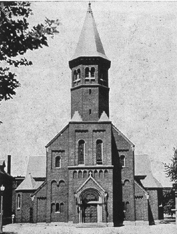
Father Kane died August 11, 1935 and was succeeded on October 15 by the present pastor, Rev. P. J. Dooley.
Father Dooley's character is in keeping with the culture of his people. He has found time to organize every modern parochial activity, take a trip to the Orient, write a book of travels, and direct the Diocesan Fire and Tornado Insurance Company.
Rev. Walter J. Tucker has ably assisted Fathers Kane and Dooley these past seventeen years. He is the connecting link between the old and the new.
In this territory poor immigrants, unskilled laborers and a whole colony of Italians settled between the years 1890 and 1900. The City
PAGE 42
built here its Poor Houses, Sanatoriums, and Isolation Hospitals. There were three distinct people scattered over this district each group having its own language and church. The first and most prominent to erect a Church were those of German origin or descent.
St. Aloysius Parish was organized in January 1892 by Vicar General Muehlsiepen. Ten of ground were purchased on Reber Place and laid out in three city blocks, the middle one being reserved for Church purposes. The other two being divided up into lots for sale to Catholic Germans. A school and frame Church was constructed which served the Parish needs till May 2, 1898 when the corner stone for the basement of a new Church was laid.
Rev. F. G. Holweck assumed charge of the parish on September 4, 1892 and continued in charge until his appointment to St. Francis de Sales Church May 14, 1903. Father Holweck was one of the most distinguished scholars among the clergy of St. Louis and was given the honor of Monsignor a few years before his death. He was succeeded by Rev, Francis G. Brand who continues to be pastor of St. Aloysius.
Father Brand has been an untiring builder and organizer. As the number of the congregation increased new buildings had to be constructed. He enlarged the school, built a convent, rectory and a beautiful Gothic Church which was dedicated by Archbishop Glennon, April 25, 1926.
The erection of St. Aloysius Parish though it overlapped the territory entrusted to St. James Parish did not effect the English speaking Catholic Community. In the locality near St. Aloysius Church there were many English speaking people, these also determined to organize a parish. In July 1893, Father John White was appointed pastor of this new parish, Holy Innocents. Elizabeth Avenue was set as the boundary line thus cutting into St. James Parish on the southeast side. Gradually the ring was being formed around St, James Parish. Each new parish that was established lessening its territory and its revenue, till the founding of the Immaculate Conception Maplewood, Feb. 8, 1904, of the Epiphany Feb. 5, 1911 and of St. Luke's Parish Sept. 26, 1914 completed the circle and confined St. James Parish to its present boundaries.
Father White within a period of a month had a little frame Church ready for occupation which was dedicated August 13, 1893. The parish during his pastorate was always poor and struggling. After many years of futile effort Father White resigned and was succeeded by Rev. T. F. O'Sullivan who built the school within a short period of his stay in the Parish. He was succeeded by Rev. Leo McAtee, a priest who has extraordinary ability and determination to do great things under great difficulties. Since his appointment to Holy Innocents the Parish has developed and the congregation has increased. He and his zealous assistant are making splendid efforts to build the spiritual and temporal welfare of the Parish.
In the decade from 1900, immigrants from the north of Italy, Piemontese, Venetians, Lombards, congregated and formed a colony which was known as "Dago Hill" and later became Fairmount Heights. These people were industrious and fitted into the industrial needs of the district in the southwest of the City where a number of brick-yards, clay factories and other industries were established. They were in need of a church and Father Spigardi erected a frame building on the "hill" which was dedicated August 3, 1903. by Archbishop Glennon. For two years this remained a mission of St. Charles Borremeo's Church. In 1905 Father Julian Carotti was appointed pastor and the mission was made a parish. On January 1, 1906, Father Carotti opened St. Ambrose school and organized various sodalities. From this time on the Italians on the hill began to grasp the wonderful opportunities offered them in their new homeland and their development in all ways was rapid and remarkable. National and fraternal societies were also organized at Fairmount Heights. Amongst them were Nord-Italia, Alta Italia, Anita Garibaldi, Megara Augusta, Guglielo Marconi, Principe de Piemonte, Regina Elena and St. Anna.
Frequently, one of other of these organizations holds celebrations and arouses the whole neighborhood to a consciousness that something of unusual importance happened somewhere, sometime, and because of it all the Italians on the "Hill" are happy. Folks are brought abruptly from their living rooms to the front porch by the bursting of bombs in time to see the sky lighted in the many color flares of skyrockets. When these flares are in the direction of "Dago Hill," it is certain the celebration is for a Fiesta and not in honor of a Mussolini victory.
Though most of the Italians who came to St. Louis around 1900 had little else than a little trunk and a few clothes; nearly every-one now on the hill and Cheltenham District have their own comfortable homes and automobiles. The World's Fair attracted to St. Louis Italian artists and craftsmen. The old
PAGE 43
world background enabled them to add some thing to the aesthetic and cultural development of St. Louis.
The Italian people, though they have an abiding and intense appreciation of their homeland are loyal to the flag of the United States. The World War gave them a special opportunity to show their patriotism for the land of their adoption. These people subscribed generously to liberty and victory bonds. A high percentage of Italians commingled with other soldiers of the American Legion and Gold Stars are affectionately treasured in many a home on the hill.
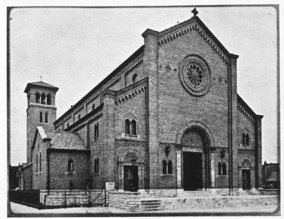
Italians are by no means new-comers to St. Louis. It was an Italian Bishop Rosati, who constructed the old cathedral and consecrated it. There was once a Vicar-General in St. Louis who was an Italian. There was scarcely ever a time that the Italian merchant was not found in the Commission Row, in the fruit business in St. Louis. Amongst these were immigrants whose children are still with us. We note the names of Ghio, Cicardi, Bernero, Massa, Curotti, Cella, Sambuccette, Devoti, etc.
Nor are all the Italians on the hill. When the ground space became too congested, the late-comers had to take the lower levels and many of them settled among the Germans and Irish of St. James in Cheltenham. In a very short time they became acclimated to the atmosphere. Their children availed of the opportunity the free parochial school at St. James Church and one of their boys, Anthony Palumbo, was the first Italian in St. Louis, probably in a period of 40 years, who became a priest in the Archdiocese. He is now assistant pastor at St. Ambrose Church. After his appointment there it was said the Italians could not understand his speech. His dialect was a mixture of English-Italian, with a few words of Gaelic thrown in. Because of his associations with Father O'Connor, undoubtedly, there are traces of the Kerry accent in his speech and his faith has the "Hall Mark" of Ireland.
In 1921 St. Ambrose Church was almost totally destroyed by fire. The building of a new church was immediately proposed. Temporarily a small chapel was provided and plans for a new church. At this time Father Carotti became afflicted with an illness which forced him to become inactive.
Archbishop Glennon appointed as administrator of St. Ambrose, the Rev. Julius Giovannini, whose work as assistant pastor of Our Lady help of Christians Church at Tenth and Wash had attracted attention.
This was one of the most critical times for St. Ambrose parish. With the grave illness of Father Carotti and the great debt of $30,000.00 resting on the parish, and because of the fire only a basement for a Church, it was indeed a trying moment for the faithful Ambrosians.
Father Giovannini, with great courage, took the situation in hand, overcame all difficulties and with the cooperation of his good parishioners paid $7,000.00 on the indebtedness in three months and by May 1, 1924 had 1iquidated all indebtedness.
Father Giovannini's promises continued to be met so that work on the construction of the new church was begun and the cornerstone laid on May 30, 1925, at which Archbishop Glennon assisted.
On May 1, 1926, the new Church of St. Ambrose, built at a cost of $200,000.00 and
PAGE 44
standing as a monument of Italian Art, was finished. The Architect was Angelo Corrubla.
Father Giovannini died on November 1, 1929, after a few days' illness in St. John's Hospital. His assistant, Father Pietro Barabino, was appointed pastor and in the period between 1929 to 1934 he reduced the indebtedness to $75,000.00. He spoke French, German, Latin and Italian fluently. His principle hobby was airplanes. He died after a lingering illness at the age of 56.
Father Fiorenzo Lupo was appointed to succeed him on April 19, 1934. He had been Pastor of St. Charles Borremeo's Church and was ably fitted for his appointment at St. Ambrose because of his ability and association with the Italian people. He, also, speaks several languages and has worked among the people Of Mexico and South America. Besides being assisted by Father Palumbo, he was assisted until December 18, 1936, by Rev. John Wieberg, who had a tragic death In an automobile accident.
There is at present an indebtedness of $15,000.00 on the church and the next undertaking of the people of St. Ambrose will undoubtedly be an addition to the school. At present the building is inadequate as there are 1,000 children of school age on the "hill" with accommodation for only 300.
Prior to 1904, the Catholics of the territory known as Maplewood belonged either to St. James Parish or to that of Webster Groves. On February 8, 1904, Archbishop Glennon authorized Rev. D. W Clark to organize a parish between St. James and Webster Groves, to be known as Maplewood Parish. Father Clark's first visit to Maplewood, then to him unknown territory. occupied by unknown people, was on Sunday, February 14. Accompanied by Mr. Basil Elder and Mr. Wm. F. Ebbing, he sought a place to be temporarily used as a Church. A vacant store at Bellevue and Manchester Avenues was selected as the only place suitable. The work Of transforming an abandoned feed store into the semblance of a Church was immediately begun. With the hearty cooperation of the Catholics of Maplewood and the material assistance of the Pastor and people of St. Theresa's Parish, the necessary improvements were completed, pews and an altar put in place, sacred vessels, vestments, etc., procured so that it was possible to offer up the Holy Sacrifice of the Mass for the first time in Maplewood on Sunday, March 6. 1904. A permanent place of worship was the next object of solicitude. After looking over various sites, it was decided to purchase property on Anna Avenue as most centrally located and reasonable in price. It was not a beauty spot by any means, being very low and its main adornments a healthy growth of tall, strong weeds and all the rubbish of the neighborhood.
In July, 1904, 300 feet of property was purchased and the work of drawing plans, excavating and building begun. In November, 1905, a substantial building was in readiness for occupancy. The building is of brick with foundation and basement of concrete, 100 by 54 feet in dimensions. There is a large, deep basement, a first floor having six rooms that was the original school, and a second floor which was used for a church until the end of the year 1926, when the new Church was completed. Since then the old building has been occupied as a school. This building was dedicated by Archbishop Glennon on November 26, 1905, under the title of the Immaculate Conception. The school opened in 1906 with 150 pupils taught by three sisters of Loretto.
In 1914 Father Clark exchanged his parish for that of Rev. M. J. Taylor of New Madrid. He had a tragic death July 27, 1916. (Rothensteiner's History of St. Louis Archdiocese.) The engine of a motorboat which he and one of his parishioners rode in the Mississippi River ceased to function near Paducah and was tossed all night by a storm. In the morning the boat was brought to the shore and Father Clark's companion went to get assistance. The place was a wilderness and there was no house in sight. On his return to the boat, Father Clark was missing and it was supposed that he also tried to locate a farm house. For several days the hunt continued until his body was found prostrate over a trunk of a fallen tree. The Coroner decided he died of heart disease from overexertion.
Father M. J. Taylor succeeded Father Clark at Maplewood as pastor and remained there until his death May 25, 1921. During these seven years, Father Taylor paid off a $13,500.00 debt, purchased and paid for the property for the site of the new Church, and left to his successor, Father Ryan, $7,000.00 in the treasury.
Father John P. Ryan was appointed to the Immaculate Conception Church February 22, 1922. His first improvement to the parish buildings was the installation of two fire escapes to the school; immediately he thoroughly organized the parish; he rebuilt sodalities, and aroused the congregation to the
PAGE 45
need of building a new Church. There was system and good judgment in everything that he did and soon the parishioners realized that they had an earnest, untiring and persistent Pastor. The Church fund increased quickly and the Church Committee and the various modalities gave splendid co-operation, In May, 1925, ground was broken for the new Church at the corner of Marshall and Moller Avenues. On August 27. the corner-stone was laid and on October 10, 1926, the Church was dedicated. The building is of impressive proportions. The tower of the Church can be seen for a long distance. In the tower is a belfry and the resonance of the bells and their music can frequently be heard as far as St. James Church.
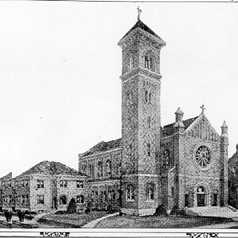
IMMACULATE CONCEPTION CHURCH, Maplewood
The building was planned by Henry P. Hess, an architect, who has probably designed more ecclesiastical buildings in the Archdiocese than any of his competitors. The Church is a magnificent model of the Romanesque style of architecture of the sixteenth century period. At present the church is not at its best but when the new altar that is contemplated is erected and the walls of the church are frescoed this church will take its place amongst the most practical and artistic churches in the City or suburbs.
The Rev. John P. Ryan was born at Rosemore, County Tipperrary, Ireland, and ordained at St. Patrick's College, Thurles, Ireland, on June 17, 1906. He was assistant pastor at St. Rose's Church, St. Louis, until June, 1918, when he was appointed pastor of St. Joseph's Church at Farmington, Mo. He is assisted by Rev. John V. Christ.
There is a drive on at the present time to build a convent for the efficient Sisters of Loretto who teach in the Immaculate Conception School. Father Ryan has not forgotten them. He is going to build them very soon a beautiful convent. We are a little bit jealous of him. He is always ahead of St. James. First with his Church and now with his convent.
Charles Gratiot, at an early date began to offer for sale parts of his immense tract of land. About the year 1825 he sold 480 acres to James C. Sutton, and this farm is the site of the greater part of Maplewood. One part of this tract he sold for $1.12 1/2 an acre and the second section was sold by him or some other purchaser to Mr. Sutton at the price of $4.00 per acre. The purchase price of the two sections was about $1.000.00 (William L. Thomas History.) It would be difficult to estimate what the present value of this piece of real estate might be. Undoubtedly, it would run into millions. This property extended along the present City Limits and Sutton home, a log house 1833, was not far from Pacific Station at Maplewood. It was built near a spring, as was customary. "Mr. Sutton," states a news clipping dated July 19, 1877, "... came to St. Louis in 1819 from New Jersey. He was a blacksmith and had a shop at 323 Second Street. He introduced iron tires to put on two-wheel barouches and wagons for the wealthy citizens. He also introduced the "Sutton Plow" to break up prairie sod and iron teeth for harrows."
The family built a Rock House two years later, a portion of which still remains at 7451 Manchester. A grandson of James C. Sutton, Charles S. Humphreys, resides at 2631 Sutton Avenue. He is the son of Sarah Sutton.
PAGE 46
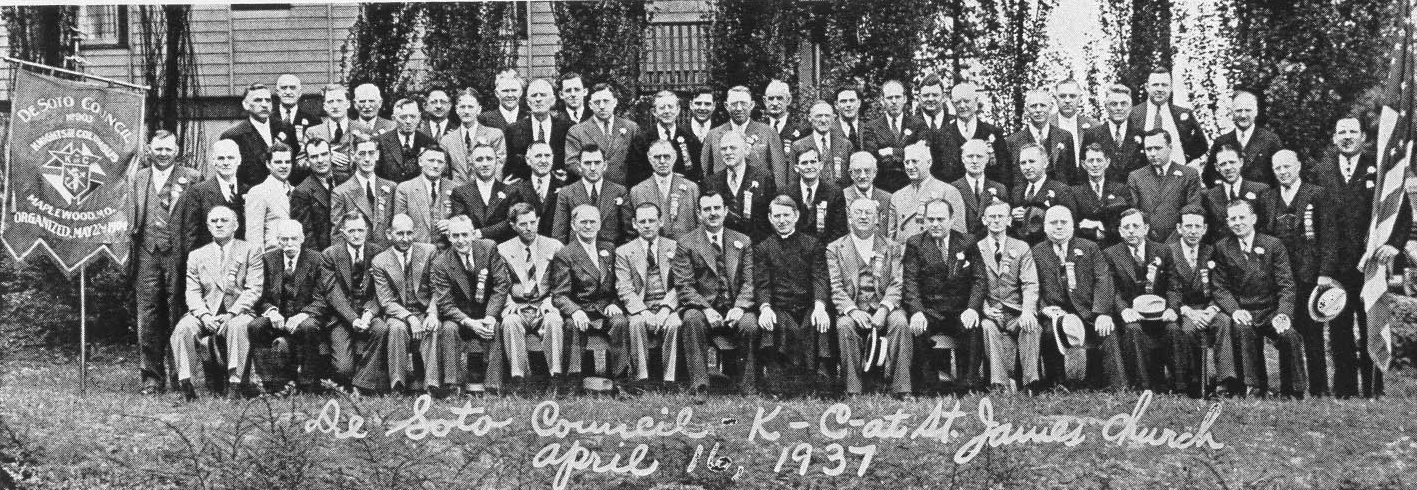
DESOTO COUNCIL K-C-at St. James Church
April 16, 1937
HISTORY OF DE SOTO COUNCIL, No. 903, K OF C. OF MAPLEWOOD
De Soto Council, No. 903, Knights of Columbus of Maplewood was instituted May 22, 1904, at West End Hall, Vandeventer and Finney Avenues, St. Louis Mo. by Hon. John S. Leahy, who was State Deputy at that time. The class consisted of 36 candidates recruited from all parts of the city. Those instrumental in organizing the Council were Wm. F. Ebbing, now of Cincinnati, Ohio; Henry C. Dreiling, of Maplewood; Patrick J. Kinsella, of Kirkwood; and Judge H. Stecker (deceased), of Clayton. To these Christian gentlemen belongs the credit for the existence of De Soto Council today, now in its 34th year.
From this meager beginning with only 36 members, De Soto Council grew by leaps and bounds until a membership of more than 350 was attained. At different periods various other councils were formed in St. Louis County the De Soto Council, contributing the nucleus for the new council, notably Clayton, Kirkwood, Webster Groves, University City, Overland and Fenton Councils. De Soto Council is rightly called the "Mother Council" of St. Louis County.
The list of the charter members of the Council was composed of the following: E.S. Block, John F. Byrnes, John F. Cahill, Rev. Father D, W. Clarke, Thos. H. Dempsey, later ordained to the priesthood, Henry C. Dreiling. George T. Dunn, Wm. F. Ebbing, first grand knight; Joe. H. Eisner, Samuel R. Evans, John W. Gainsy, Dr. F. E. Guibor, Norris Heege, Henry J. Jennemann, Wm. R. Kehoe, Dan Kelly, Dan J. Kelly, Pat J. McDonnell, Ernst J. McWilliams, Jacob W. Mertz, John J. Murphy, John C. Nead, P. H. Nolan, Thos. M. O'Gorman, Edw. C. Oncken, Jerome A. Owens, John A. Parker, Thos. J. Rafery, Fred L. Schneider, Henry Stecker, Henry J. Timmermann and Anton Wunderlich.
The present officers of De Soto Council are as follows. Grand Knight, David T. Draper; Deputy Grand Knight, Earl B. Wagner; Chancellor, Roy J. Lee; Financial Secretary, Wm. J. Maxwell; Recording Secretary, Dan Callahan; Treasurer, Dr. E. F. Rehm; Warden, Fred Blase, Advocate, Paul Koenig; Inner Guard, John A. Baelke; Outer Guard, Spencer Aubuchon; Trustees, Stephen Godfrey, John Moran, W. J. Miggins; Chaplain, Rev. Father P. J. O'Connor; Delegate to the Chapter, Earl B. Wagner;
De Soto Council, No. 903, Knights of Columbus of Maplewood was instituted May 22, 1904, at West End Hall, Vandeventer and Finney Avenues, St. Louis Mo. by Hon. John S. Leahy, who was State Deputy at that time. The class consisted of 36 candidates recruited from all parts of the city. Those instrumental in organizing the Council were Wm. F. Ebbing, now of Cincinnati, Ohio; Henry C. Dreiling, of Maplewood; Patrick J. Kinsella, of Kirkwood; and Judge H. Stecker (deceased), of Clayton. To these Christian gentlemen belongs the credit for the existence of De Soto Council today, now in its 34th year.
From this meager beginning with only 36 members, De Soto Council grew by leaps and bounds until a membership of more than 350 was attained. At different periods various other councils were formed in St. Louis County the De Soto Council, contributing the nucleus for the new council, notably Clayton, Kirkwood, Webster Groves, University City, Overland and Fenton Councils. De Soto Council is rightly called the "Mother Council" of St. Louis County.
The list of the charter members of the Council was composed of the following: E.S. Block, John F. Byrnes, John F. Cahill, Rev. Father D, W. Clarke, Thos. H. Dempsey, later ordained to the priesthood, Henry C. Dreiling. George T. Dunn, Wm. F. Ebbing, first grand knight; Joe. H. Eisner, Samuel R. Evans, John W. Gainsy, Dr. F. E. Guibor, Norris Heege, Henry J. Jennemann, Wm. R. Kehoe, Dan Kelly, Dan J. Kelly, Pat J. McDonnell, Ernst J. McWilliams, Jacob W. Mertz, John J. Murphy, John C. Nead, P. H. Nolan, Thos. M. O'Gorman, Edw. C. Oncken, Jerome A. Owens, John A. Parker, Thos. J. Rafery, Fred L. Schneider, Henry Stecker, Henry J. Timmermann and Anton Wunderlich.
The present officers of De Soto Council are as follows. Grand Knight, David T. Draper; Deputy Grand Knight, Earl B. Wagner; Chancellor, Roy J. Lee; Financial Secretary, Wm. J. Maxwell; Recording Secretary, Dan Callahan; Treasurer, Dr. E. F. Rehm; Warden, Fred Blase, Advocate, Paul Koenig; Inner Guard, John A. Baelke; Outer Guard, Spencer Aubuchon; Trustees, Stephen Godfrey, John Moran, W. J. Miggins; Chaplain, Rev. Father P. J. O'Connor; Delegate to the Chapter, Earl B. Wagner;
PAGE 47
Lecturers: Wm. Schmeeder, Leo Lanham; Associate Editor of the Mariner, Savoy W. Pereau, now serving his 14th term.
Those who have served the Council as Past Grand Knights are: Wm. F. Ebbing, Pat J. Kinsella, Gee. T, Dunn, Jerome A. Owens, Henry C. Dreiling, Mark A. Watson, Thos, H. Murphy, Fred M. Murphy, Jos. P. Waddock, M.J. Croghan, Hubert Hoeflinger, Raphael R. Dolan, Henry A. Foan, Walter J. Dunn, James R. Porter, Wm. A. Gibbar and Edwin V. Kelly.
De Soto Council has been honored by the appointment from its ranks of three District Deputies. viz- Hubert Hoeffinger. Raphael R. Dolan and James R. Porter, now serving his fourth term. De Soto Council is the proud possessor of its own hall at 7318 Manchester Avenue. A pretentious brick building of two stories and basement, containing two large stores on the first floor. It was purchased during the administration of M. J. Croghan at a cost of about $8,500. The property has a market value today of close to $50,000. Title to the building is vested in the De Soto Building Corporation. De Soto Council is proud of the work accomplished in the past 33 years, and proud of its beloved Chaplain, Rev. Father P. J. O'Connor. Savoy W. Pereau
The Knights of Columbus was founded in New Haven, Conn., on February 2. 1882, as a fraternal and insurance society for Catholic men. The organizers Were Rev. M. J. McGivney, Rev. P. P. Lawlor, Joe. T. Mullen, Cornelius T. Driscoll, Dr. M. C. O'Connor, Daniel Colwell, Wm. M. Geary, John T. Kerrigan, Bartholomew Healey and Micheal Cullen.
The declared purpose of the organizers was to perform the work of an apostolate of the laity. During the fifty-five years of its existence the Order has done notable work in providing education and homes for Catholic orphans; hospital service for the sick, employment for the needy, and sponsoring lectures to give non-Catholics a better understanding of the Catholic faith.
The Society was incorporated in Connecticut on March 29, 1882 and the first Council, Salvador, Number 1. chartered on May 15 of the same year. The first Council out-side Connecticut was chartered at Westerley. R. 1. April 15, 1885. Councils are now located in all parts of the United States, Canada and most countries of the Western Hemisphere. The Fourth Degree was instituted in New York City, February 22, 1900.
Chas. S. Humphreys, the son of Sarah Sutton, is a "chip off the old block" and apparently a pedigree tells. He served in the City Council, five terms. his first election taking place in 1909. He was elected Mayor of in 1927, succeeded himself in 1931. With one exception he is the only Mayor to serve three consecutive terms. Mr. Humphreys was born in Maplewood November 15, 1868 on the site now occupied by the Masonic Temple on Manchester Avenue. He was one of six children.
His Excellency Archbishop Glennon, appointed in 1910 Rev. Jos. F. English, the assistant pastor of St. James Parish, to make a survey of the district that is covered by the Epiphany parish and advise with him as to whether in accordance with obvious spiritual needs, a parish or a mission of St. James should be established there. The movement to organize this parish was begun by James J. O'Toole, James Cunningham, Samuel Bushell and John Maxwell. The first meeting attended by Father English was held at the home of Samuel Bushell at Odell and Ivanhoe Avenue. Besides the original promoters. Patrick Barry, Wm. D. Coleman, James McElevy, John W. Maxwell and possibly one or two others were present. It was decided to request His Grace to permit Mass to be offered in one of the local stores on Sundays as soon as possible. Official recognition was given to the Mission Feb 5. 1911. An old dilapidated store building was secured at Ivanhoe Avenue and Arloe Station and Father English arranged to have Rev. C. M. Donovan of Kenrick Seminary celebrate the Mass.
On September 8, 1911 Father English was officially appointed administrator of the parish and came to reside in a frame building in the 6700 block of Scanlan Avenue. About this time he decided to call the Church
Epiphany
Why he gave it this name is not evident. Possibly he associated the four promoters with the three wise men who came from the East, but more likely he had in mind the beauty and attractiveness of a child and the special adoration that is due to the Holy Infant of Bethlehem. Then, too, east of him was the parish of Holy Innocents, so there was a similarity and a twinship established between the two by their names.
From September 1911 to December 8, 1912, Church services were held in an abandoned "Nickelodeon" building on the east side of Ivanhoe Avenue between Scanlan and
PAGE 48
Bradley Avenues. A school was opened in this building in 1911 by two sisters of St. Dominic, Sister Mary Cecelia and Sister John Baptist. A choir was organized by W. J. I Maxwell. The members being Mary and Virginia Ryan, Geraldine and May Fanning, Nan and Ullian Smythe, Agnes Kempf, Helen Philibert, Edwin Maxwell, Raymond Philibert, Julian Philibert. Ann Maxwell was organist. The first High Mass was sung in the Church Christmas 1911.
Father English set about purchasing a permanent location for church and school and secured 200 feet of ground on Smiley Avenue. The corner-stone for the combination building was laid on Sunday, September 8, 1912, by Father Gilfillan, later Bishop of St. Joseph, Missouri. The address was made by Rev. P. P. Crane, now Monsignor Crane, Vicar-General of the Archdiocese. In this selection Father English exercised excellent judgment. He was a little bit ahead of the Holy Father in his appreciation of the ability of these two priests. This edifice was completed within a year and Rev. John Lynch of St. Agnes Parish, was selected and said the first Mass on December 8, 1912 in the church section of this building. The architect was Thos. F. Imbs and the general contractor was Fred Hof, a parishioner. The altar was donated by Mrs. R. S. Colnon and the two statues of adoring angels were donated by Dr. and Mrs. J. P. Hennerichs, Jr.
The school was transferred to the two east rooms on the first floor and the sisters' quarters were in the west rooms on the same floor. On the east side a rectory was built which later became the Convent. In 1914 the corner lot on Ivanhoe Avenue was purchased parishioners contributing the price, each paying for one or more feet at $22.00 per foot.
In 1915 the sisters' quarters in the school were given over for school rooms and a house was rented for their use at 3129 Ivanhoe Avenue. In 1916 the present Rectory was built. In 1918 another one hundred feet on Ivanhoe Avenue was purchased from the proceeds of a Carnival. In 1928 the indebtedness of the parish amounted to $11,660.00. At that time an intensive campaign was decided upon with the slogan Let's Burn the Mortgage on the Feast of the Epiphany" and by cooperation and energetic efforts of the trustees, directed by Joseph W. Stewart, Chairman, the movement was brought to a successful termination an the Feast of the Epiphany, January 6, 1929 and the parish was then free of all debt.
An addition was made to the rear of the 1929 ground for the new Church was broken and the corner stone was laid by Archbishop Glennon on April 27, 1930. The architect of the Church was Thos. F. Imbs. The style of architecture is Lombardy Romanesque with tracts of the Renaissance. The building has a seating capacity for 750 people. The entire cost of the building including all its furnishings was $100.000.00. Of this sum $10,000.00 was contributed by parishioners while the church was under construction and the indebtedness has been reduced each year until now there is a balance of only $47,000.00. The Church was dedicated on September 14, 1930.
Father Jos. F. English was born October 17, 1877 at Queenstown. County Cork, Ireland.
PAGE 49
He was educated at Kenrick Seminary and, completed his theological course at the North American College, Rome. He was ordained at St. John Lateran Church, Rome on June 17, 1905. His first appointment was assistant pastor at St. Agnes where he served until August 15, 1909 and Father Casey being granted a leave of absence because of illness, Father English was appointed Administrator of St. James Parish and served in that capacity for nine months. After Father Casey's return to the parish Father English continued to be assistant until he was appointed to the Epiphany parish on September 8, 1911.
There are very few men who have had such a building program as Father English. In the past twenty-five years he has organized the Epiphany and erected all the buildings that are required by a modern parish. These include Church, School, Hall, Convent, Rectory and even a garage. There is a splendid playground for the children. The parish has grown from one hundred families to 600 and the school from 100 pupils and a few teachers to 320 pupils and seven teachers. Father English is a man of fine physique and is recognized as a man of unusual oratorical ability. (As to his naming the parish Epiphany, Father English commends my explanation, but claims that he was determined to follow good advice and "hitch his pants to a star," (Ed. note,)
When a parish is struggling to meet an indebtedness, the losing of a single contributing family is keenly felt. Father Casey parted with the families that were cut off from his parish and given to St. Luke's as a man might part with a member of his body upon the operating table. Father Collins hoped to get a big slice of the limb. Father Casey wanted to give only the toes. The location of a site for the new parish was another bone of contention. After Forest Avenue was decided to be the dividing line, it was evident to Father Casey that the nearer St. Luke's Church came to this line, the greater would be the difficulty of retaining the parishioners thereon. Hence, he endeavored to have the two Churches at least equidistant from the boundary, or if not, that his parish, because of its age, should be given a handicap. It is to be feared he used his influence with some of St. Luke's parishioners to have the site of the Church further west than its present location.
St. Luke's parish was established in October, 1914, and Rev. Jos. A. Collins was transferred from Farmington, Missouri, to establish the parish. A conference of prospective parishioners was held immediately and Father Collins decided to have a priest come at once from St. Louis University to say Mass in the old Christy Mansion at 2101 Bellevue Avenue. After a month, Father Collins became permanently settled in the territory and secured quarters at 1229 Sunset Avenue, Wildermuth's home, and set about purchasing property for the parish. After overcoming some opposition, he finally purchased the Barnett property at Delta and Bellevue Avenues and said Mass til 1917 in the Barnett home which was on the property. On October the 16th, 1917, he had dedicated the combination church and school that was erected on Bellevue Avenue at a cost $20,000. Father Collins had an exceptional know of building construction. He was familiar with every detail of price and material because prior to his coming to St. Luke's he had just completed the beautiful Church in Farmington. The day of the dedication, the Archbishop complimented him on his economy and said, "There was not another building in the Archdiocese that was as beautiful and commodious at the price." That same year three sisters of St. Joseph were selected by Father Collins to take charge of the school. In a short time the Parish "buzzed" with life and activity.
On the death of Monsignor Tallon at the Visitation church, Father Collins was given what was presumed to be a promotion and asked to take charge of this parish. In obedience he accepted the will of the Archbishop and with regrets he and the good people of St. Luke's parted.
On November 1, 1920, Rev. Jos. A. McMahon, pastor of Portageville, Missouri, was assigned to St. Luke's. In the course of time many St. Louis Catholics were moving westward and St. Luke's received its share of view parishioners. As a consequence, a new Church became imperative and a drive was made for funds. The response was encouraging. It was evident that Father McMahon was winning the hearts of his people. As he himself said the night he was received by the parishioners, "I know you are grieving for the loss of your beloved friend and pastor, Father Collins. I am a stranger among you and I appreciate your loyalty, but as a new shoe is a little difficult to wear at first, I hope that after I am broken in I will be serviceable"
Father McMahon is now a well-worn old shoe in St. Luke's parish but he is hale and hardy and much beloved by all his parishioners. He is singularly suited to the modern needs of parish life that calls for numerous activities to attract and hold youthful members of the congregation. From his early days he was an enthusiast about athletics. As a
PAGE 50
student, he played in a soccer game against the team in St. James parish and it is said he was a hard man to hold down. He still retains his enthusiasm and rarely passes up an important soccer game or ice carnival. He even puts on the skates on feet that seem to be too agile for his venerable head.
In October, 1924, Father McMahon purchased the property on Bellevue and Dale Avenue for a new Church and parochial residence. On May 6, 1928, Archbishop Glennon laid the corner-stone of the present magnificent Church which cost about $215,000.00. It was dedicated on June 21, 1929, in the presence of a large number of priests, sisters and members of the laity. Father Michael Ryan, C. M., President of Kenrick Seminary, of happy memory, preached on the occasion a masterful sermon. The exterior of the Church is very beautiful. It is of Bedford stone. The style of architecture is early English Gothic with traces of Norman characteristics. The Church has strength and unity and this is emphasized by an elegant tower. The interior of the Church is simple and neat. Its elegance arises from the beauty of its construction. It is devoid of pillars except those in the transepts and has a seating capacity of 850.
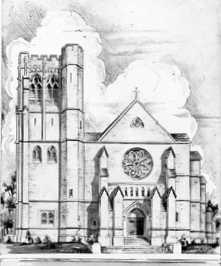
SAINT LUKE'S CHURCH
Richmond Heights
After the new Church was opened, the combination church and school building was reconstructed for school purposes. There are 350 children and eight teachers in the school. The beautiful Bischoff home adjoining the Church on Dave Avenue was purchased by the parish and is now the rectory. The parish has about seven hundred families. There are four buildings on the property, the Church, the Priest House, the School, and the Convent.
Father McMahon was barn in St. Theresa's parish, St. Louis, on the 29th of September, 1880, and was ordained at Kenrick Seminary in June 1905. He served as assistant pastor at Sts. Mary and Joseph's Church in St. Louis from 1905 to 1910; at the Immaculate Conception, St. Louis, from 1910 to 1913; at DeSoto for one year and at the Sacred Heart parish, St. Louis, 1915 to 1917, when he was appointed pastor of Portageville.
Father Jos. M. O'Toole is assistant pastor. A Father from the Holy Family Mission also assists Father McMahon. Father O'Toole has distinguished himself among the young people as a promoter of dramatics. St. Luke's players have a city-wide reputation.
In the northwest quarter of the Gratiot League -- Sterrett's addition, between Wise and South (now Oakland) Avenues, from Yale to Big Bend. Adjoining that addition on the east is the Peter Lindell Estate sub-division, between Wise and Oakland, from the City Limits to Yale Avenue.
Blendon was first applied when a north and South street was laid out between Manchester and Glades Avenues. The street was named for Blendon Campbell, son of Geo. W. Campbell. Blendon Place comprised 686 acres. We are indebted for this and other historical items of interest to Mr. Geo. Wm. Tucker whose present residence is 1039 Blendon Place.
PAGE 51
Very likely the first Parochial School in St. Louis to organize an Alumni Association was St. James. With a formal Banquet following Graduation Day, those who have gone before welcome and promise to assist those just passing from the school room into the business world or into the higher places of learning. The sociability of class-mates and the spirit of Alumni relationship should thus be continued throughout life. St. James Alumni Society offers are: Mr. William Hefele, Jr., President; Mr. Hubert Ward, Vice-President; Miss Virginia Pursley, Secretary; Miss Mary O'Connell, Assistant Secretary; Miss Florence Wilsdon, Treasurer; Mr. John Coad, Chairman of Entertainment and Mr. Norman Fehrensen, Secretary of Entertainment.
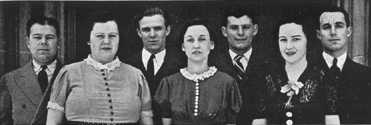
ALUMNI OFFICERS -- 1936-37
Left to Right: Norman Fehrensen, Secretary. Entertainment: Virtinai Pursley, Secretary: William Hefele, President: Florence Wilson, Treasure: Hurbert Ward, Vice President: Mary O'Connell, Secretary: John Coad, Chairman Entertainment.
Following is a list of Graduates from St. James Parochial School, since the year 1904. Those marked with an asterisk have moved from the Parish.
Following graduated under Sister M. Catherine, as Superior; assisted by Sisters Louis, Loyola, Bernadette, Benigna, Colomba, Alphonsus, Emily, Bertrand, Geraldine, Corona, Frances.
*Joseph L. Brady, *Edward Cody, Joseph Gibbons, -- Wlliam Hefele, *Eugene Donnelly, Agnes Houlihan, Anna Cody, *Josephine Komoros, Helen Finn, -- *Louis Howland, *G.S. McCloskey, *T. J. Hines, Paul O'Gorman, *Justine Mahon --*Frank Signaigo, *William Gallaher, *Ray Dolan, Genevieve Mahon, *Dena Kreutzer, *Olinda Knobel, Catherine Moran. *Ida Murphy, *John Shaffrey -- *Gertrude Dennell, *Nellie Nolan, Marie O'Gorman, *Verna Neddo, James Gallaher, *Edward Signaigo, *Hugh Gibbons -- Lillian Hense, *Esther Howard, *Kathleen Morrissey, *Mary Nolan, *Margaret Saxton, Raymond Bayers, *Michael Oates, *John O'Gorman, *John Usher, -- *Patrick J. Flavin, *Frank J. Gilbane, *Daniel J. Kreutzer, *Teresa M. Manion, *Anna T. Owens -- *Irene A. Barr, *James N. Dean, Helen C. Dolan -- *Cecilia E. A. Gerard, *Veronica M. Heverle, *Meehan J. Kelly, Harold O. Kern, John J. Long, *Dorothy M. Lynch, *Thomas Lynch, Catherine A. McGuire, *Owen J. Mcvey, *Ellen J. Morrissey, *Charles R. Morrissey, *Thomas F. Oates, *Genevieve H. O'Gorman, Mary A. O'Hare, *Margaret M. Signaigo, Matthew J. Shaffrey, Mary A. Smith, *Catherine Usher, William P. White, -- James Dolan, Joseph Donnelly, *Joseph Flavin, *Thomas Flavin, Harry Gallaher, *Helen Gerard, James Gibbons, Leo Hefele, Helen Howard, John Hruby, Anna Kurz, *John LaGrace, Francis Manion, *Ben Maloney, John McAnnar, Dan Murphy, *James Nolan, *Helen Olney, *Laura Shaffrey, Margaret Smith, Blanche Thompson, *Albert Vallar --*Margaret C. Corbion, *Helen M. Flavin, Timothy J. Flynn, Hazel A. Long, *Bernadine Muth, *Sylvester J. McKenna, *Helen Saxton, *Joseph P. Signaigo -- *Ester M. Arnold, *John T. Booncher, *Francis Cramer, *Alice M. Devaney, Florence G. Ehle, Myra M. Gallaher, Joseph A. Hruby, *Nelson A. Howard, *Eager H. Kelly, *Hildegard C. Kriesgshauser, *Linda M. Kurz, Harry P. Maloney, *Rosalie A. Moran, *Hazel M. C. O'Donnell, *Amice T. O'Gorman, *Florent E. O'Gorman. *Margaret A. O'Hare, *Anna E. Rose, *Leola M. Shaffrey, *Helen J. Usher, *Katherine M. White -- *Viola T. Barr, Helen M. Brady, Frederick J. Coad, Stanley J. Cunningham, Edward P. Dolan, *Hannah B. Flavin, *James A. Flavin, Delphena E. Jones, *Evelyn M. Jones, *Anna Mae T. Kenney, *Julia A. Lynch, *Vincent D, Malone, *Parthenia E. Pate, Daniel A. Prindible, *Marion J. Rose. *Janice A. Smith -- *Eleanor U. Bannon, George L Bayers, Anthony A. Clegg, *Helen L. Coad, *Anna M. Dolan, Louise M. Dwyer, *Mary P. Flynn, *Margaret M. Gibbons, *Joseph M. Maloney, *Mary C. McKenna, *Emily G. McKenna, Ella M. McVey, *Walter W. Miller, John F. Moore, *Eugenia M. Morrissey, Julia M. O'Connell, Sarita A. Placke, Thomas E. Quirk, *Nellie Scully, *Hazel C. Schmitt, *Festus Signaigo, *Corinne M. Witt -- Margaret McDonnell, *Marie Dwyer, *Helen Bawn, *Margaret Flynn, *Marie Kelly, *Loraene Howard, Catherine Hruby, Mary O"Shaughnessy, William Pate, *James Manahan, George Cody, *Walter Kelly, *Louis Rose, *Samuel Morrissey, Euphronious Jones, *Mary Murphy, Dela Shaffrey -- *Alvina A. Barr, *Margaret M. Black, Mary A. Devaney,
PAGE 52
*John P. Dolan, James M. Dwyer, *Mary Flavin, *Agnus Flood, *Helen Flynn, Charles Gallaher, *Anne Gibbons, *Adele Jirauch, Camille Jones, *Eric Luechtefeld, Helen Luddon, Helen Maloney, *Veronica McKenna. *Fred McKenna, *Florence Minneboo, Annette Newport, John O'Connell, *Charlotte O'Gorman, *Louis O'Gorman, Marie Pate, *Estelle Sensenbrenner, *Elizabeth Signaigo, *Virginia A. Steebler, *Raymond Esher.
Graduated under Sister M. Alphonsus, as Superior; assisted by Sisters Germaine, Joselita, Matthew, Beatrice, Petronilla, Bernice, Anastasia, Mercedes, Hubert, Victorine, Frances Borgia, Frances, Thekla.
Ada Bolt, *Walter Barr, *Josephine Berry, *Colleen Bawn, *Arthur Curlee, Margeret Coad, John Egli, James Egli, Edmund Fannen,*Mario Gioia, Virginia Jones, *Jane Lynch, *Dorothy McKenna, Agnes McLaughlin, Anthony Matreci, *Francis Morrissey, Martin Moore, *Ruth May, Frances O'Shaughnessy, John O'Shaghnessy, *Ferdinand Ritter, *August Sensenbrenner, *Rosemary Wiss, *Dennis Dwyer, James Ianuzzi, *Elizabeth Dressel, Charles McVey -- Margaret Wiber, *Marie T. Gibbons, *Pauline H. Epstein, *Irene C. Vallar, *Victoria C. Kelly, *Mary, J. Syron, *Anthony A. Palumbo, *Joseph E. Ryan, William P. O'Shaughnessy, *Clarence J. Adler, *Henry J. Riddle, Bernard A. Huff, Michael A. Newport, Edward P. Thiele, *Victor M. O'Gorman, *Cecil E.Peppers, *Dennis J. Coed -- Margaret Bannon, *Thomas Curlee, Helen Dolan, Randall Dwyer, Cornelia Gruner, Joseph Huff, *Adele Hynes, Margaret Irvin. Charles Jones, Helen Kelly, John Mahon, Talbot Murphy, *Adolph Menner, Ellen Moore, *Mary Maenal, Nora O'Shaughnessy, Loretta Pate, Tony Pilla, *Arthur Pahl, *Dot Riddle, *Albert Staebler, *Thognas Syron, *W. Syron, Catherine Sudgen, *Genevieve Woods, *Sterling Rose, Elizabeth Spiez, Loretta Cooper, Joseph Cenatiempo -- Geraldine Arlt, Thomas Brady, Margaret Cenatiempo, Eleanor Egli, Theresa Gioia, Edwin Flood, Mary Harris, *William Hynes, Theresa Jones, Margaret Ludden, *Catherine Mahon, Francis Mahoney, *Rosemary Newport, Estelle Nixon, *Helen Oetter, Margaret Oates, *Frank Pursley, *Bernardine Quinn, *Helen Reynolds, Walter Strathman, Ida Smith, Rose Schatzle, *Helen Sullivan, Joseph Wiss, *Mary Wilson, *Margaret Bates, *Eva Wodiker -- *Helen Ryan, *Louise Bawn, *Catherine Coad, Frances Doering, Madge Maloney, May Collins, Genevieve Nixon, *Mary Wack, Florence Wilsdon, *Helen Oates, *Genevieve Martineau, Mary O'Connell, Ethel Irvin, *Stasia Lawler, Dolores Arit, *Angela Kollias, *Bertha Reynolds, *Edward Quinn, *Eugene Martineau, Joseph Cadwallader, Harry Wagner, John Corbett, *Felix Wiget, *Harry Coble, Francis Jirauch, *Louis Schollmeyer, Cornelius Flynn, *Charles Kavanaugh -- *Waldo Bisso, Joseph Phelan, John Doering, William Corbett, Renard Gruner, Frank Strathman, Norman Fehrensen, Orval Harnes, Angelo Pilla, Emmet Jones, *Joseph Hussman, Bernard Thiele, John Fannen, *Maurice Sullivan, Dorothy Brady, Margaret Huff, Rose Gioia, *Evelyn Lutz, *Lorraine Lutz, Estelle Coad, *Christina Hobbs, *Mary McCauley, Dolores Brady, *Regina Bernsen, Lillian Saxton, *Rosalie May, Sylvia Blazitz, M. Hester Bovard.
Graduated under Sister M. Gabriel as Superior; assisted by Sisters Raymunda, Patrice, Celestine, Jeanette, Estelle, Marietta, Marie Therese, Hilda, Jacqueline, Tarcisium, Macrina, Vincentia, George.
Ione Arnold, *Lillian Bernsen, Ruth Bovard, Lucille Cenatiempo, Francis Dwyer, George Epstein, Joseph Gioia, *Charles Heil, *Cornelius Kavanaugh, *Ruth Kelly, *Anthony Kollias, *Otheo Lauterwasser, Francis Manestar, Frances Matreci, *Dorothy Martineau, Matthew McLaughlin, *Monica Moynihan, Catherine O'Shaughnessy, Anna Purcell, Virginia Pursley, Catherine Reese, Margaret Regan, Joseph Schmid, *Philomena Shaffrey, *Agnes Stanton, Bertha Stoverink, *Henry Stoverink, Laura Stumpf -- Mary Corbett, Verda Berach, *Betty Kavanaugh, Augusta Mergenthaler, Margaret Matreci, Margaret O'Shaughnessy, Loretta Oates, *Bessie Cob1e, Virginia Coad, Helen Chiaurro, Grace Kelly, Dorothy Buescher, Lucille Plengemeier, Ita McCauley, Bernard Brady, John Spiesz, Woodrow Foley, George Eckhoff, Charles Corbett, *Robert Duggan, Joseph Sharamitaro, *Glennon Burke, Louis Schatzle, *Bernard Quinn, Frank Dailey, *Margaret Waltz, *John Houlihan, Bennie Sudgen, Teddy Thiele, Eugene Lively -- James Cadwallader, Carlo Cenatiempo, John Coad, Mary Claire Duggan, Agnes Frattini, *William Hazelett, Edmond Hefele, Mary Kearney, *Bernard Kelly, Rosemary Kelly, James King, August Matreci, *Clara May, Dorothy McLaughlin, Evelyn Mergenthaler, *Paul Menner, James O'Connell, Ruth Pierce, John Pursley, Imelda Saxton, Edward Schuler, Alice Schersinger, *Gertrude Stoverink -- Eugene Godfrey, Katherine Maloney, Eileen Houlihan, *Heien Hazelett, Florence Kelly, *Helen Martineau, Albertine Bigney, Eleanor Knickel, *Antonette Palumbo, Mary C, McGrath, Veronica Duggan, Virginia Arnold, *Loyola Charleville, Helen Kelly, Julia O'Shaughnessy, Thomas O;Shaughnessy, Byron Fannen, Robert Mahoney, Charles Schatzle, Jack Oates, Louis Schmid, *Harmann Duvall, Dominick Borrelli, Edward Cadwallader, Joseph Jirauch, *Sylvester Nuelle, *Henry Hugeback, Andrew Doering. John Murphy, Lawrence Beinecke, Dean Bisso, *Harold Thompson. Raymond Buescher. *Robert Kelly --*Russell Gittins, Woodrow Harnes, William Hefele, *Harvey Howard. James Newport, William Reese, William Saxton, Lawrence Schuler, Joseph Pilla, Paschal Palumbo, Alice Corbett, Julia Duvall, Mary Eichner, Margaret Gruner, Bella Borrelli, Mary Burch, Veronica Brady, Verinica Coad, Ruth Heil, Rose Kearney, Grace Kelly, *Elizabeth Ross, Rosalind Reese, Helen Scherzinger, Mary Stockero, Mildred Sullivan, Adeline Schmitz, *Alice Jane Webb, -- Lawrence Arlt, *Daniel Burke, Rosemary Bigney, *Victoria Calcatera, Daniel Coad, Robert Corbett, Clara Duvall, Agnes Duggan, Melvin Ehrlick, *Florence Foy, *Virginia Fahey, *Mary Louise Godfrey, Catherine Hefele, Joseph Kearney, *Helen Kilderry, James Lawless, *Joseph Moor, James Mouldon, Harold Plengemeier, Muriel Roach, *Mary Jane Robertson, Lester Stumpf, Mildred Saxton, Catherine Vellios, Lester Whitmore.
Graduated under Sister M. Georgiana, as Superior; assisted by Sisters George, Macrina, Tarcisius, Hilda, Jacqueline, Antonia, Flavian, Grace, Mildred, Ancilla, Kathleen, Thomas, Alice, Isabel, Ann Patrice.
James Brady, Albert Bueacher, Benedict Cenatempo, James Coad, Edward Corbett, Edward Duggan, James Kelly, Arthur Lafser, Robert Lauterwasser, Thomas Marshall, John McCauley, Morris McEvoy, Francis McLaughlin, *Robert Mudd, Harold Myers, Peter Palumbo, Paul Pursley, *Helgarde Rademeyer, Mitchell Scherzinsger, *Herman Stoverink, Hubert Ward, Dorothy Bertram, Hermetta Burch, Rose Capelli, Bernice Coad, Antoinette Daddona, Margaret Purcell, Helen Reese, Sadie Shamarmitaro, Alice Thomas -- *Allen Baer, John Barry, Maxine Bertram, Walter Cadwallader, *Peter Caleaterra, Lawrence Dempsey, Eileen Duggan, *Gertrude Foy, Raymond Harris, Francis Hart, Mary Jane Hruby, Bernadine Hugeback, James Jackle, John Kelly, Marie Knickel, Owen Lavin, Mauresetta Lindauer, Mildred Maloney, Joseph Menner, Frances Mergenthaler, Eleanor Morrissey, Edward Regan, Joseph Sharamitaro, Leonard Strathman, Emil Vilcek, Rita Ward -- John Andertson, Timothy Barry, Dorothy Beinecke, Mildred Eichner, Lester Gagan, Mary Gioia, Mary Ellen Griffin, William Griffin, Edward Hart, Loretta Henne, Carmelita Kelly, Mary Catherine Kelley, *Mary Alice Kilderry,
PAGE 53
Charles Klasek, Anna Marie Lafaer, Margaret Lawless, Dorothy Morkoetter, *David Mudd, James Page, *Edna Rademeyer, Joseph Regan, Mary Virginia Regan. Mary Jane Reese, Mary Louise Reese, Mae Rocchio, George Scherzinger, Joseph Schieher, Jane Schmid, Ruth Siemer, John Stumpf, Edward Sugden, *Robert Wack, *William Wack, Elmer Whitmore, Dolores Zundel -- Robert Anderson, Charles Billings, Mary Margaret Bonskowski. Thomas Brady, Edward Buckley, Charleen Burch, Michael Cenatiempo, Thomas Coad, Louise Columba, Virginia Cutelli, Anna Dempsey, John Dolan, Gloria Duggan, John Eichner, Albert Frattini, Grace Gallagher. *Rolla Gittens, Mary Gruner, Rosemary Hasty, William Henne. Francis Houlihan, Alexander Kotkis, Frederick Kuykendall, John Lavin, Dorothy Marshall, Bernard McAnnor, Lillian McEvoy, Daniel Murphy, *LaVerne Noonan, Francis Poll, Agnes Riegel, Rose Rocchio, Robert Saxton, Arthur Schmitz, *Richard Wack, Helen Frances Walsh, Norbert Wynn -- *Josephine Barni, Edward Barry, Maureen Barry, Catherine Billings, William Boman, Paul Bequette, Andrew Buckley. Richmond Buettman, Mildred Burt, Catherine Capelli, Paul Coad, Robert Coad, Julia Columbo, Thomas Conroy, Geraldine Corbett, Walter Drooge, Raymond Gallagher, John Garavaglia, Catherine M. Hruby, Gerard Hugeback, James Lossos, Johanna Mazzucca, Eileen McCauley, Mary McMahon, Mary Menner, Henry Nebuloni, Norma Nebuloni, John Palumbo, John Pedersen, Eileen Regan, *Lorraine Robben, Jane Scherzinger, Herbert Schmitz, Verda Schmitz, Ruth Walden, Margaret Whitmore, Hubert Williams --
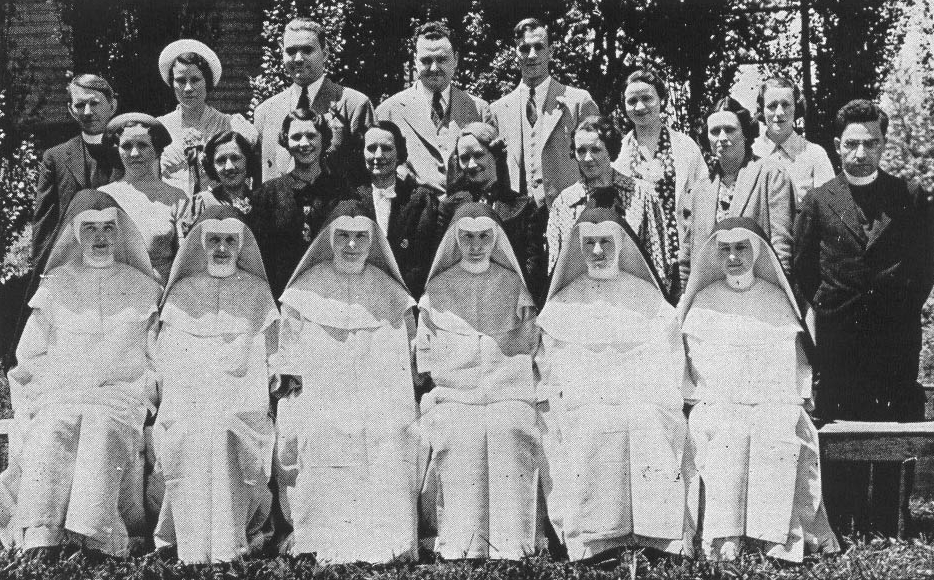
THE GRADUATES WHO MADE A VISIT
Rev. P.J. O'Connor ------------------------ Rev. A.A. Palumbo
Nuns: Sr. Delphine, Sr. Hubert, Sr. Rose Miriam, Sr. Bernice, Sr. Matthew, Sr. Ancilia.
Second Row: Helen LeRoy, Mrs. C. Hansen, Pauline Johnson, Rosalie Moran, Mrs. H. Thurber, Mrs. L. Smith, Mrs. V. O'Gorman.
Third Row: Mary Syron, Vincent Malone, Dr. R. Usher, Henry Hugeback, Genevieve O'Gorman, Mrs. W. Byrne.
Robert Baerveldt, Helen Bonskowaki. Catherine Corbett, William Cumberland, Georgianna Diefenbach, Robert Dolan, Marie Dyer, Joseph Eichner, William Flanagan, William Godfrey, June Haenichen, Emma Harness, Margaret Hart, Marjorie Houlihan, Audry Hruby, Catherine Kearney, Catherine Lafaer, Walter Lochlien, Mary Jane Lossos, Robert Marshall, James McMahon, Mary Ellen McVey, Marion Mergenthaler, Mary Jane Meyer, Geneva Miller, Anthony Mirrelli, Mary Alice Moulden, John Murphy, Margaret O'Donnell, James O'Shaughnessy, Vernon Page, Constance Piestrup, Genevieve Ready, Celeste Riegel, Helen Roach, Theresa Roach, Louis Santambrogio, David Saxton, Lawrence Schieber, Loretta Schinsky, Margaret Spain, Owen Thompson, John Vorbeck, Elizabeth Walsh, James Walsh, John Weaver.
The number that did not graduate and who attended St. James School is far in excess of those who are listed as graduates. Until recent years it was not customary for children of the poor to remain in school until they had completed the eighth grade. Most of them went to work at the ages of 12 or 13 and are as Catholic and as zealous in the practice of their religion in most instances as are the graduates. (School Register, 1902-1925.)
For the rest of the book go to:
| HOME | DOGTOWN |
| Bibliography | Oral history | Recorded history | Photos |
| YOUR page | External links | Walking Tour |